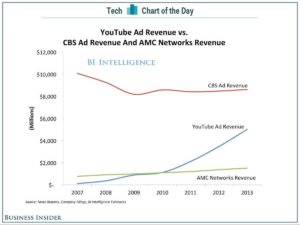A Measure of Quantity, Not Quality
 A CPM is a media measure that values the cost-per-mille (or cost-per-thousand impressions) for an ad campaign buy.
A CPM is a media measure that values the cost-per-mille (or cost-per-thousand impressions) for an ad campaign buy.
It’s a legacy from radio and TV advertising. Networks estimated the size of their audiences so they could calculate how many times ads were exposed to listeners and viewers (impressions) and place a dollar value on that number (CPMs).
The challenge was they had no way to determine the quality of impressions. Even today, when a network or station runs a TV commercial, no one really knows for certain how many people actually watch it, or whether they are viewers that the advertiser really wants to target. Still, CPMs remain the primary units for selling and buying TV and radio.
A Whole New View
As digital media have evolved (initially, online display but more recently, video), they have followed in the footsteps of traditional media in using impressions and CPMs for selling ads. Most brands and agencies today buy display and video ads on a CPM basis.
However, ad technology companies have been steadily innovating more precise ways to measure the size and character of ad audiences, as well as their engagement with ads. And this insight has prompted a new focus on a much more valuable metric—the view.

The good news for video advertisers is that, in time, most of the digital media market will trade on the true value of a video campaign: how many people actually watch your entire ad—and who they are, specifically.
The Hot-Hot-Hot Button
Viewability remains the hot-hot-hot button issue of the day as more brands and agency media planners realize just how few of the video ad CPMs they pay for are ever seen.
Many video ad publishers and networks built their systems on legacy display ad technology and in many cases, it can’t distinguish between user-initiated and forced-view video ads, tagging both as impressions.
How bad is it? Integral Ad Science recently reported that, viewers never see 60% of the video ads that brands and agency media planners purchase outside of YouTube.1
And despite industry commitment to address this situation, the past 18 months has produced only a 1% improvement in viewability.
A Clear and Better Alternative
 In December, 2010, YouTube introduced its skipable ad format called TrueView, along with a different value model than CPMs.
In December, 2010, YouTube introduced its skipable ad format called TrueView, along with a different value model than CPMs.
The new media measure called “CPV” values the cost-per-view for a skipable video ad campaign. This model charges advertisers only when a viewer chooses to watch a full ad, or 30 seconds, whichever is shorter.
Writing in Ad Age at the time, Baljeet Singh explained why YouTube defined TrueView this way:
“Viewer intention to watch an ad is widely seen as a proxy for whether a brand message is being delivered and consumed.”2
Indeed, YouTube ad revenue has climbed steadily since then, surpassing cable networks like AMC and ESPN ad revenues, and approaching the traditional broadcast networks like NBC and CBS.
The Full Value of the View
Buying media on a cost-per-view basis produces tremendous value for brand stewards both in terms of engagement and bang for the buck.
For example, a platform like Sightly's TargetView™ optimizes YouTube TrueView campaigns to maximize views at the most cost effective CPV. The major benefits of this approach are:
- 100% of the ad spend generates full views. In other words, every ad spend dollar goes toward delivering the most relevant, highest quality video advertising engagements possible—hyper-targeted viewers who choose to watch the full ad.
- Significant added value from free partial views worth an additional 100% or more return on ad spend (ROAS). With the data generated from TrueView campaigns, we can calculate a dollar value for all the free partial views they produce—i.e., all the impressions that don't result in full views but still create significant awareness.
- Premium engagements where the ad unit is nearly 100% viewable. By targeting in-stream skipable TrueView inventory first and foremost, we deliver viewability that far exceeds industry standards. Ad viewability on YouTube overall is 91% but when you factor out forced-view ads and those that run in-display, it's likely even higher. (Unfortunately, YouTube doesn't publish viewability numbers for its particular ad formats.) Compare that to the 40% viewability that Integral Ad Science reports for the rest of video ad industry and you can see why TrueView's CPV-based ads are so much more attractive to advertisers.
As advertisers and media planners learn more about high-value CPV-based video ads like YouTube's TrueView skipable format, the day isn’t far off when CPMs are laid to rest.
If you'd like a shareable PDF copy of this article, just select this button:

